What is Christianity?

Christianity is an Abrahamic monotheistic religion based on the life and teachings of Jesus of Nazareth described principally in a group of books known as the “New testament” and in oral traditions.
Its basic creed , is that Jesus is the Son of God incarnated, who ministered, suffered, and died on a cross, but rose from the dead for the salvation of mankind and each human individually. This salvation implies a radical change in one’s life – through the divine grace – and an eternal bliss after death. The highest moral virtue of a Christian is to love all humans and consider them as brothers and sisters of the same Parent , who is God!
Its basic cult is in memory of Jesus Last Supper
Christianity began as a Judaic sect in the 1st century. During the first millenary it spread to Europe, Middle East and North Africa. During the second millenary it spread all around the world , actually being the world’s largest religion, with about 2.4 billion followers
From the very beginning its history was full of disputes and divisions which evolved over time . Actually there exist three great groups of Christian communities (churches)
-The traditional Oriental Churches which reflect the divisions till the 9th Century
-The traditional Roman Catholic Church which kept a unity of creed and cult in all its local churches and evolved separately from the Oriental ones.
-A constellation of Churches issued from the Protestant Reform in the 16th Century which separated them from the Catholic church
Though practically all churches share the same basic creed they differ in many particular points . For many churches those differences are of the highest importance . There are also profound cultural differences which (along with the dogmatic ones ) are reflected in their cults
Christianity and Dance
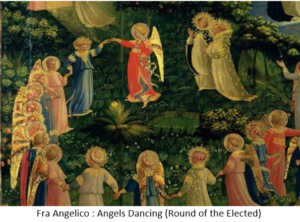
We don’t know if Jesus danced but He participated in many Jewish feasts where everybody danced.. The first Christians were Jews and participated in gatherings in which some of them were possessed by the Spirit of God .We have practically no testimonies concerning dance in Christian gatherings the first three centuries
In the fourth century Christianity became the official religion and successive pagan conversions happened all the time. New converted were attached to their dance traditions . From that period, till the Protestant Reform , almost all arts entered thoroughly in the Cult except dance. The majority of christian authorities were against dance in cult and against most forms of dance , but we have various testimonies that there was dance inside the churches at certain periods or at certain occasions . The religious authorities also encouraged dance outside the church (as lesser harm) during the medieval pilgrimages .
However , some theologians expressed a high consideration of some kinds of dance as a spiritual activity of humans and angels.
After the protestant reform, dance was expelled from all churches till the 19th century where it started coming back through some mass events called Revivals . Actually the Liturgical Dancers have introduced dance as a complete art in a part of the Protestant Churches
The Vatican Council II , considers dance incompatible with Christian cult except for some non western cultures
The oriental churches are still resisting even to the idea of introducing dance to the cult with the notable exception of the Ethiopian church where dance is a complete part of the cult continuously till the 6th century .
Finally a very interesting point is that artists are creating choreographies inspired by the huge Christian heritage of music and poetry
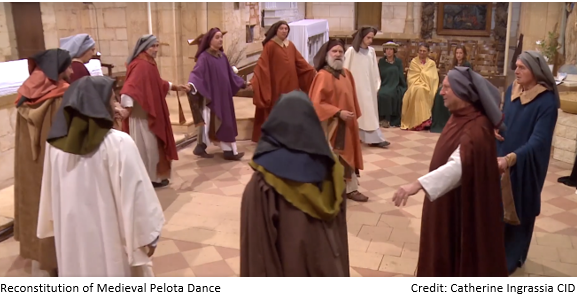
Documents
Acts of John
Excerpts from the Bible
American Catholic Church Clarification on Liturgical Dance
Suggested Readings
Issues on Dance and Christian Worship by C Kontogiannis CID
Worship God in Dance by Lucinda Coleman
Learn more on Christian Dancing through History…….
Learn more about dance and contemporary Catholic Church…..
What is Liturgical Dance ?
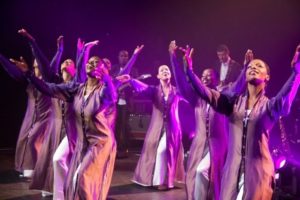 Liturgical dance is the incorporation of dance movements into worship in order to facilitate deeper spiritual experiences. Liturgical dance entails movement of body parts which accompanies worship as an expression of devotion. Dancers respond to an appropriate dancing technique which coordinates with the music and is believed to improve worship expression and devotion. Liturgical dance may either be spontaneous or have been planned in advance.
Liturgical dance is the incorporation of dance movements into worship in order to facilitate deeper spiritual experiences. Liturgical dance entails movement of body parts which accompanies worship as an expression of devotion. Dancers respond to an appropriate dancing technique which coordinates with the music and is believed to improve worship expression and devotion. Liturgical dance may either be spontaneous or have been planned in advance.
For many faith groups and believers, liturgical dancing forms an integral part of worship. Many churches consider it an acceptable form of a Christian way of worship. Liturgical dancers express the word and the spirit of the Lord through movement of various body parts. Choreograph dances are frequently used before the congregation to create exciting and emotional atmosphere. Liturgical dancers mostly use their body parts, for instance, lifting up of hands, clapping continuously, swaying the body in any direction, and moving the head to the tune of the music to express to the congregation the joy they feel within.
Learn more :
Dance in The Ethiopian Church
Zema, is a form of Christian liturgical chant practiced by the Ethiopian Orthodox Tewahedo Church. The related musical notation is known as melekket. The tradition began after the sixth century and is traditionally identified with Saint Yared. Through history, the Ethiopian liturgical chants have undergone an evolution similar to that of European liturgical chants.
Zema means a pleasing sound, a song or a melody in Ge’ez, the liturgical language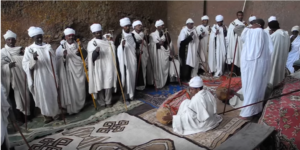
Students of Ethiopian liturgical chants study the Ge’ez language, and begin practicing singing in childhood. Education takes place in liturgical dance schools called aqwaqwam bét and includes, in addition to singing and dancing, training in traditional instruments such as the käbäro, drums, tsänatsel, sistrum, and mäqwamya. Singing students (däqä mermur) become singers (däbtära) and some will eventually become masters (märigéta). A student is considered ready when he has mastered the complicated genre of qené. It has been suggested by Monneret de Villard that liturgical dance, that always accompanies the music, has its origins in the Ancient Egyptian dance.
Learn more :
Choreographies on christian music and hymnology
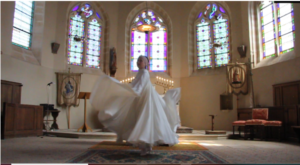
Hymns and music were continuously present from the period of the presence of Jesus (Marc 14,26) to our days. Early Christians sung using David’s psalms and simple melodies avoiding elaborate or pleasant music . From the 4th century hymnology and music evolved in order to compete with dissident (heretic) christian groups and also in the frame of rich celebrations to compete with the existing pagan ones.
From then on a fabulous treasure of hymns has been accumulated in every christian church in every period (ex Armenian, Georgian, Egyptian, Ethiopian, Arabic, Byzantine, Russian, Gregorian etc etc … till the negro spirituals and the hymns they inspired)
On the other hand since the 12th century numberless composers were inspired by Christianity (ex Hildegarde von Bingen, Palestrina, Monteverdi, Bach , Mozart ,Schubert ,Gounod ….till Arvo Pärt and John Tavener) and bequeathed us a countless number of works (Te Deum, Missas, Ave Maria, Requiem etc etc)
Maurice Béjart proved that most musical masterpieces can be choreographed and danced , even if their initial creation was irrelevant to dance.
Unfortunately up to now very few choreographies were created on religious music inspired by christianity , though their number is increasing from the 2d half of the 20th Century
An important dimension of CID’s “Dance And Spirituality “ is to encourage dancers to do so ….
Learn more ……
